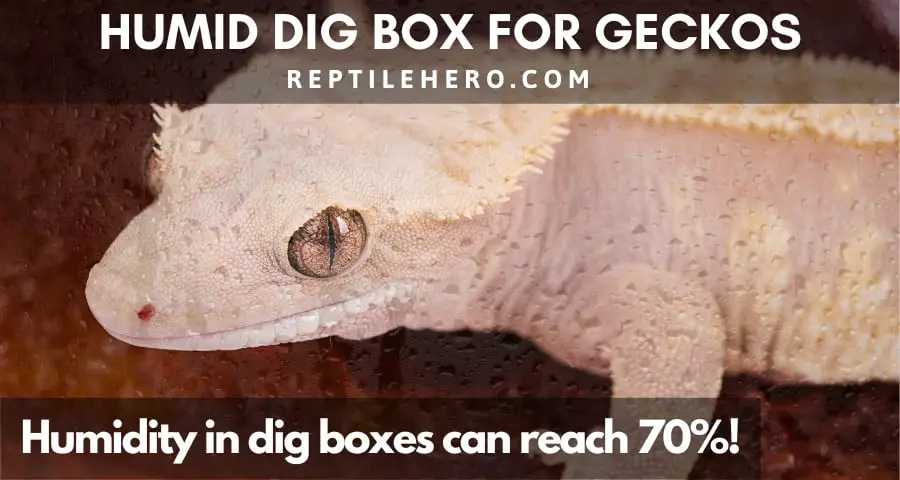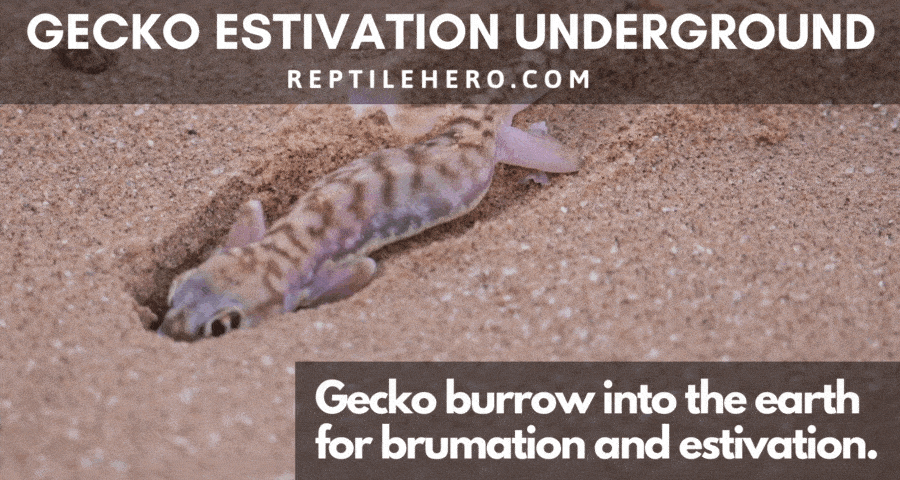Do Geckos Need a Dig Box? (5 Practical Ways They Use It!)
Some keepers think that dig boxes filled with substrate just create an unnecessary mess in gecko tanks. But is such a mess really bad? Or can providing dirt-filled dig boxes actually improve your gecko’s life?
Dig boxes are not necessary if a gecko is already housed in an enclosure with a deep and diggable substrate. Indeed, dig boxes and thick loose substrates serve the same purposes. Both aid in thermoregulation, shedding, brumation or estivation, and egg laying, as well as provide enrichment.
Well, your female geckos are definitely going to need it! Otherwise, you risk having them retain their eggs which can be fatal. Discover how else geckos use dig boxes by reading until the end!
1. Thermoregulation
Many species, including leopard and crested geckos, will burrow into their dig boxes to assist them in thermoregulation. This is because geckos are heavily reliant on their environment for maintaining preferred and optimal body temperatures.
Geckos are ectothermic—and more specifically, poikilothermic [1]. In other words, a gecko’s core temperature greatly depends on its environment, and it has little to no ability to maintain optimal temperatures on its own.
This is where a dig box can come in handy!
During the day nocturnal geckos (nocturnal), like the African fat-tailed gecko, tend to use the dig box more on excessively hot days to cool down. They will stay under the burrow, out of direct light and heat, in the cool and moist lower layers of the substrate in the box.
Geckos that become active during the day (diurnal), such as the Moorish gecko, tend to use the dig box more often on really chilly nights to retain as much body heat as possible.
Those active during dawn and dusk (crepuscular) and ones with irregular times of activity (cathemeral) do a combination of both.
2. Shedding
Dig boxes containing sufficiently moist substrate help geckos shed their old skin successfully and painlessly. Geckos that have access to this in their tanks can shed well without the intervention of owners.
Some gecko keepers use a tank provision that combines dig boxes and humid hides to ensure a good shed each time. When kept moist, humidity can be boosted to about 70% inside this hide box.

In fact, one friend of mine—who own a couple of geckos—no longer has to give his cold-bellied babies regular soaks and sauna sessions outside of their enclosures thanks to this. The added texture will also help them get rid of their shed without hurting themselves.
Learn more about tips for good shedding in our article on bad stuck shed.
Besides giving his geckos humid-digging spots, he also gives them big shallow bowls of clean water regularly. Ever since he started doing this, he didn’t have to disturb and bring his geckos out of their tanks unless it was really necessary.
As a result, his geckos were much more active and comfortable with exploring every inch of their decked-out tanks. Now, I’m not saying that taking geckos out of their tanks for soaks and sauna sessions to help them shed more easily is bad. I actually recommend them!
However, if there is a way to help them shed in a less intrusive way, then I recommend it much more. Because as much as we enjoy their company, they won’t always appreciate ours.
3. Brumation or Estivation
A gecko that is native to a temperate region, like the western banded gecko, may benefit from a dig box if a keeper wants to induce brumation during really cold winters. The same is true for a tropical gecko, like gargoyle geckos, that will benefit from estivation, a state of dormancy during very hot or dry summers.
Similar to brumation, estivation is a period of inactivity that a gecko will normally go through in the wild. The two main difference between the two is time and temperature [2].
Brumation happens during the winter when temperatures drop, whereas estivation happens during the summer when temperatures skyrocket.
Keep in mind, that this doesn’t only happen to geckos that are living in their native habitats. Geckos can experience either dormant phases in captivity if a keeper or breeder wishes to do so.
However, this is a practice that is only recommended for experienced gecko owners as badly implemented brumation and estivation can result in the animal’s demise.
As I have explained earlier, having a dig box with a deep and moist substrate to retreat to can help a gecko survive—and even thrive—through such a challenging time.

The dig box can not only help them stay warm or cool (depending on the situation) but also help keep them hydrated underground.
4. Egg Laying
Providing lay or dig boxes for female geckos is especially advised. This is essential for facilitating egg laying. When a gravid gecko is not given a dig box with a moist substrate, it may refuse to lay eggs and become egg-bound.
Here, it’s important to keep in mind that female geckos can lay eggs whether or not they have ever been cohabbed or paired with a male. Just like chickens, a gecko can lay infertile eggs regularly.
So even if you only have an unpaired female gecko in your care, it’s always good to give them a secure space with plenty of bedding to dig through so that they can safely pass eggs.
Find out more in our article on what gecko eggs look like.
But the provision of dig boxes for gravid geckos is more relevant for geckos that produce soft-shelled eggs like leopard and crested geckos.
In contrast, species like tokay geckos produce hard-shelled eggs and deposit them on rocks, inside hollow trunks, and within cave ceilings and walls.
Fun Fact: Some geckos, like the northern spiny-tailed gecko (Strophurus ciliaris), lay their eggs in communal nesting burrows. This is because it is proved that the humid environment in such underground spaces fosters good egg development.
5. Enrichment
Giving geckos a dig box is a means of enrichment that prevents boredom and its negative consequences like self-mutilation. More specifically, a dig box can provide sensory, climate, and environmental enrichment for geckos.
Although it’s funny to see videos on the internet capturing geckos glass surfing, tearing up paper towels, or digging into their calcium bowls, this—in reality—is a sign that your gecko is incredibly bored!
Unfortunately, many newbies and inexperienced reptile keepers mistake such behaviors as a show of their pets wanting attention. But what they actually want—and need—in such cases is stimulation, which you can provide through enrichment.
Discover its pros and cons in our article on explaining enrichment.
One of the simplest ways to offer geckos enrichment is to provide them with a diggable substrate.
The substrate in the dig box does not need to be bioactive. A simple mix of soil, play sand, clay, and other natural loose substrate options will do (here on Amazon).
Contained Dig Box vs Diggable Tank Substrate
More often than not, keepers with geckos that are sick or are dealing with life-long conditions that greatly limit their movements prefer dig boxes over tanks that are completely filled with loose diggable substrate.
Others compromise by filling ⅓ to ⅔ of the tank floor with diggable substrate and the rest with solid floorings like slate tile, or vice versa.
So even though I personally advocate for diggable tank substrates, you should do what’s best for you and your gecko.
Further Questions
What is a gecko dig box?
A dig box is a tank provision created by filling a container with a loose substrate that is safe for geckos. Some owners create a naturalistic dig box by gluing together tiles or rocks, while others reuse old food-safe microwavable plastic containers.
How deep should the substrate in a gecko’s dig box be?
Ideally, the substrate in the dig box should be at least 4-6 inches deep depending on the gecko’s size and species. Bigger geckos will require not only a deeper substrate but also a bigger box so that they can comfortably move around and bury themselves completely in it.
Can a gecko survive without a dig box?
Pet geckos can survive in captivity even if they are not given a dig box in their tanks and they are on solid and sterile substrate. However, most experts still recommend providing geckos with a dig box to improve their overall welfare.
Where should you place the dig box in a gecko tank?
The placement of the dig box in a gecko’s tank does not matter greatly. Gecko owners have placed it in the warm end, cool end, and even middle area without any issues whatsoever. However, it’s advisable to place it in an area with a lot of shade and coverage to provide security and prevent the substrate from becoming too dry.
How often should you change the dig box substrate?
Owners should regularly change the dig box substrate to prevent the development of harmful bacteria and mold in a reptile tank. Most experienced keepers and breeders recommend doing this at least once a week. To be more specific, it is advisable to change the dig box bedding once it gets soiled.
Is it okay to give a gecko in quarantine a dig box?
As it is easy to replace and remove a dig box even in a quarantine setup, experts say that owners can place it even in quarantine setups. This allows geckos to thermoregulate effectively and entertain themselves even in a considerably sterile environment.
Why isn’t your gecko using its dig box?
It is normal for geckos to not immediately use their dig box as it is foreign to them. However, they are likely going to start using it once they have ascertained that it is safe for them. Then again, some geckos don’t take much to dig boxes and use them quite seldomly.
Summary of Do Geckos Need a Dig Box?
Most reptile experts recommend giving geckos dig boxes as it serves multiple functions that can greatly improve a gecko’s life in captivity.
Geckos make use of dig boxes to 1) cool down or stay warm, 2) shed properly, 3) brumate or estivate safely, 4) lay eggs successfully, and 5) live an enriched life in captivity.
Sources
[1] https://www.iacuc.pitt.edu/sites/default/files/guide_careanduse_laboratoryanimals_0.pdf
[2] https://www.nps.gov/articles/reptiles-and-amphibians-ecology.htm



![5 Causes of Denting on Your Gecko Eggs [and 4 Solutions]](https://www.reptilehero.com/wp-content/uploads/2021/03/G38-768x614.jpg)
![What Do Gecko Eggs Look Like? [Size, Color, and More]](https://www.reptilehero.com/wp-content/uploads/2021/03/word-image-25-768x576.png)
![Why is Your Leopard Gecko’s Nose Red? [9 Causes and Solutions]](https://www.reptilehero.com/wp-content/uploads/2021/10/Red-nose-gecko-cc-768x614.jpg)
![How Do Geckos Walk on Walls? [With Science]](https://www.reptilehero.com/wp-content/uploads/2021/10/G44_-_Redesign-768x614.jpg)
